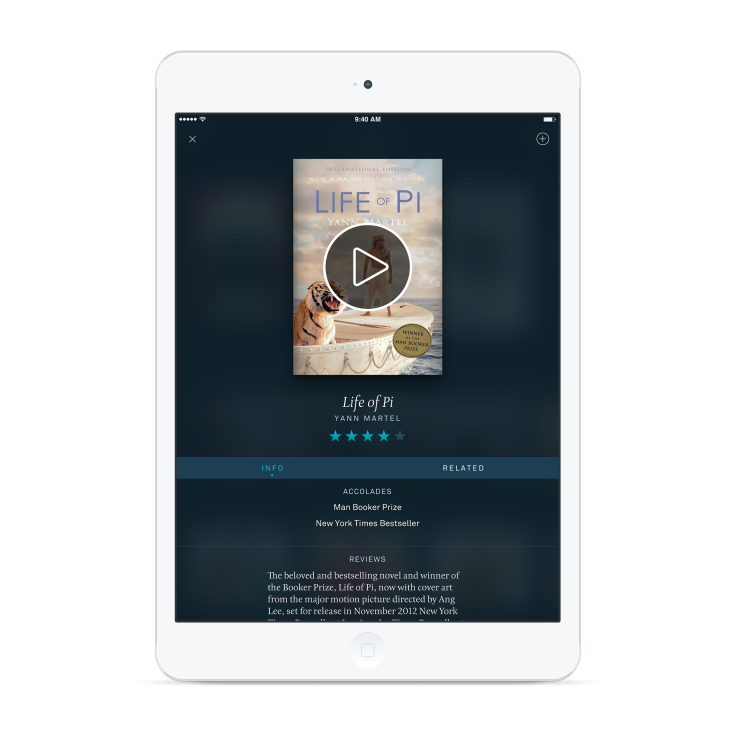Why Oyster Isn't 'The Netflix Of Books'

A new service is making its rounds on the marketing circuit. Oyster is being hailed as the “Netflix of books,” great for bookworms who consume multitudes of reading material in a month’s time. For the low price of $9.95 a month, subscribers get access to “over 100,000 titles,” across a myriad of genres, available at the touch on their Apple devices. But while this service looks great on paper, the practicality of it is lacking. Here’s why Oyster isn’t actually a Netflix of books.
First things first. Obviously Netflix has been around for several years and had its fair share of ups and downs (anyone remember Qwikster?). This has turned the subscription service into the market giant it is today. The early days of Netflix lacked the original content that is moving the company from a reactionary service to a powerhouse in the entertainment industry. Netflix stated last year that their business goal was “to become HBO faster than HBO can become us.” But the hyperbolic comparison is not why Oyster fails to earn the moniker.
It’s real failing is in what the service provides. Granted, unlimited anything is instantly attractive. Game shows offer unlimited, or lifetime supplies all the time. But what exactly is unlimited when it comes to reading? Unlimited books do nothing if you don’t read them, and reading has a limit. It has a limit in time and speed, something most people do not possess.
Consider the average reading speed. The average speed in the United States is around 200 to 250 words per minute, less when it’s on a monitor. With the average novel being somewhere in the 50,000- to 100,000-word range (as defined by the National Novel Writing Month competition), that makes the average time to read a novel somewhere between 200 to 500 minutes, or three and a half to eight hours of reading time.
According to the US Bureau of Labor Statistics, Americans 15 and older spend 2.8 hours a day watching TV, over half of their 5.2 hours of daily leisure activities. Considering that people are not going to change their television consumption habits, this leaves a little under two and a half hours of leisure time available. The next highest amount of time spent is socializing, at just under an hour a day. So the viable amount of time available to read comes surprisingly low, just about 99 minutes a day. While the same study outlines reading for pleasure, it just states, “Time spent reading for personal interest and playing games or using a computer for leisure varied greatly by age.” We’ll consider that the 99 minutes a day is completely available.
Here’s where the problem exists. While the average person has just over an hour and a half to read, but takes up to eight hours to read a book, that puts the reader at around five days to read a book, around a week’s time give or take. This means that Oyster subscribers can read about four books a month, causing the value to the subscriber to be at a $2.49 per book maximum.
Conversely, Netflix doesn’t need to tap into the other spare time category, it’s lumped into the TV watching time, 2.8 hours a day. Let’s say a Netflix customer wants to watch all of "Everybody Loves Raymond," currently available on Netflix. If they only watch that show, that means they can consume approximately seven episodes a night. They will finish the series in a month. The series currently retails for $139.95 on Amazon. That means that the content per price is comparable to $140 worth of value for $8.99. It’s no surprise why Netflix is gaining customers and making money.
Ultimately, the service cannot provide consumers with enough of a value to maintain steam after the novelty of “a world of books, always within reach” ends. Generally speaking, Oyster has problems to overcome well before it is deserved of the praise it is getting. Publishers don’t need the service to get books to bookworms; it’s only available on Apple products; Amazon and Barnes and Noble provide new releases while subscription services cannot. Publishers are in the market to make money and while unlimited access is a nice sound bite, it isn’t very attractive to publishers who see their profits being undercut to maintain the $9.95 fix price.
Lastly, this isn’t a new concept. Public libraries provide the exact same content for free. The only benefit for Oyster subscribers is the ease of access. You just don’t have to go to the library. But libraries provide so much more than just books. People get newspapers, archived and new; children get read to and most public libraries offer after-school programs; libraries increase literacy for the young and the old, just to name a few.
While Oyster is in its infancy, and conceptually it can be a good service, it just isn’t there yet. The market of voracious readers is just too small, and most of those people like the feeling of a book in their hands. Oyster may be a great service down the line, but it just isn’t the “Netflix of books” yet.
© Copyright IBTimes 2024. All rights reserved.





















